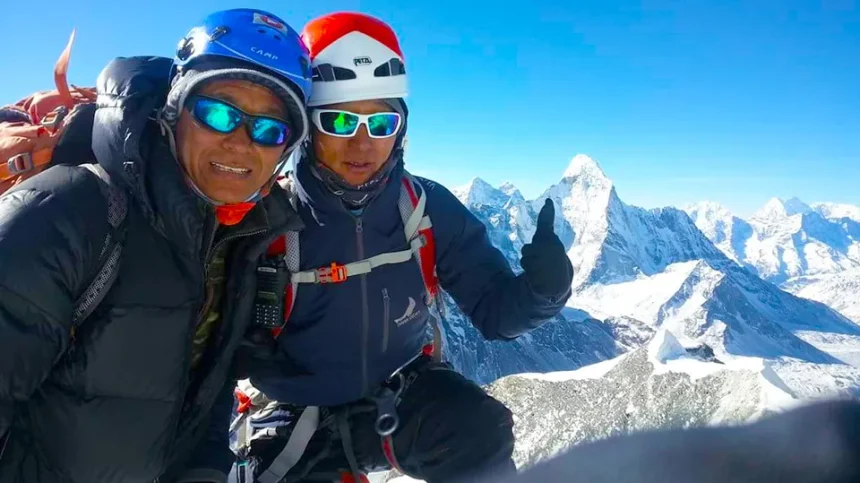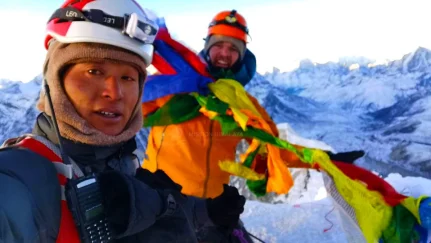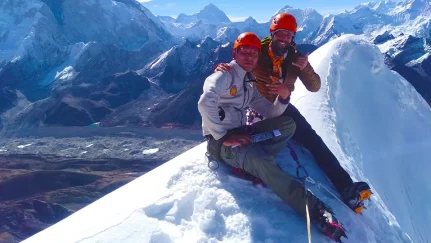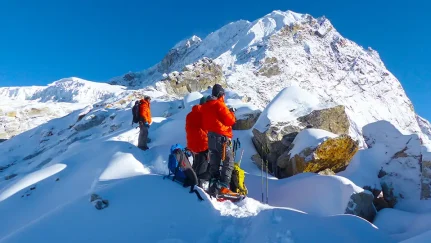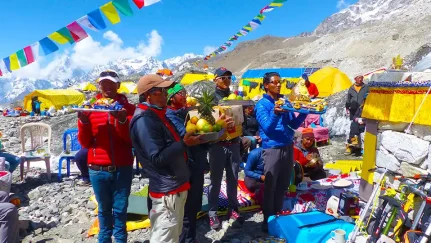Essential Tips for First-Time Climbers on Island Peak
Climbing Island Peak in Nepal is an exciting adventure, but it can also be challenging for first-time climbers. The journey requires preparation, physical fitness, and the right mindset. In this Island Peak Climbing Guide, we’ll share some essential tips to help first-time climbers succeed on this incredible mountain.
- Get Fit and Train Your Body
Before you think about climbing Island Peak, you need to be in good physical shape. The trek to Island Peak involves long days of walking, steep slopes, and altitude changes. It’s important to build your strength, endurance, and stamina. Focus on activities like hiking, running, and cycling to improve your fitness. Additionally, practice walking uphill with a backpack to get used to carrying extra weight. The better prepared your body is, the more enjoyable and safe your climb will be.
- Know Your Gear
When it comes to climbing Island Peak, the right gear is essential. You’ll need proper clothing to keep warm in cold temperatures, especially at higher altitudes. In your Island Peak Climbing Guide, you’ll find that you need insulated jackets, boots that are comfortable for long hikes, and a helmet for safety. Don’t forget about climbing equipment like crampons (spikes for your shoes) and an ice axe, which are necessary for parts of the climb. Make sure your gear fits well and is in good condition.
- Take It Slow and Acclimatize
One of the biggest challenges of climbing Island Peak is dealing with altitude. The higher you go, the less oxygen there is, which can make you feel tired or dizzy. It’s important to take things slowly to give your body time to adjust. This process is called acclimatization. Make sure to rest when needed and drink plenty of water. In your Island Peak Climbing Guide, you’ll learn that many climbers take rest days during their trek to help their bodies adjust to the thin air. Don’t rush and listen to your body.
- Hire a Guide and Porter
For first-time climbers, it’s a good idea to hire a guide or porter. A guide will help you navigate the trail, ensuring that you stay on the right path. They also provide valuable information about the area and the climb. A porter can carry some of your gear, which will make the trek easier and less tiring. In your Island Peak Climbing Guide, it’s clear that having a guide and porter can make the experience safer and more enjoyable, especially if you’re new to mountain climbing.
- Stay Positive and Be Prepared for Challenges
Climbing Island Peak can be tough, especially when you face difficult weather or steep sections. It’s important to stay positive and keep going even when things get hard. Having a good attitude will help you push through tough moments. Remember, you can always turn to your guide or fellow climbers for encouragement. In your Island Peak Climbing Guide, you’ll learn that staying calm and focused is key to reaching the top.
Climbing Island Peak is an unforgettable experience, and with the right preparation, first-time climbers can make it to the summit. Use these essential tips, get ready physically and mentally, and enjoy the adventure of a lifetime.
Choosing the Best Route: A Detailed Overview of Island Peak Climbing Paths
When you decide to climb Island Peak in Nepal, one of the most important things to consider is choosing the best route. The path you take can greatly affect your experience, so it’s important to know your options. In this Island Peak Climbing Guide, we will walk you through the different routes to help you decide which one is best for you.
- The Main Route from Chhukung
The most popular and straightforward route to climb Island Peak begins at Chhukung. Chhukung is a small village that is located near the base of Island Peak. From here, climbers follow a well-marked trail that takes them through rocky terrain and moraines (piles of rocks left by glaciers). As you climb, you will pass through beautiful high-altitude landscapes and eventually reach the base camp of Island Peak.
This route is favored by many climbers because it is relatively easy to follow, and it is the starting point for most treks to Island Peak. In the Island Peak Climbing Guide, it is mentioned that this route is ideal for climbers who are physically prepared and ready to handle the challenges of higher altitudes. Although it’s not the most difficult path, it is still important to take your time and acclimatize properly to avoid altitude sickness.
- The Trek from Dingboche
Another route that some climbers choose is to start from Dingboche, which is a little higher than Chhukung. Dingboche is a village that’s popular with trekkers on their way to Everest Base Camp. Starting from Dingboche adds an extra day of hiking, but it can help you acclimatize to the altitude better. This route involves trekking through forests, past yak pastures, and eventually reaching Chhukung, where you can join the main route up to Island Peak.
In the Island Peak Climbing Guide, this route is recommended for trekkers who want to spend more time in the mountains before starting their climb. It gives you a chance to get used to the altitude gradually and provides some extra time to adjust your body. For first-time climbers, this option might be better if you want to ease into the climb.
- The Gokyo Lakes Route
For those looking for a longer and more scenic option, you can take the Gokyo Lakes route. This path starts from Gokyo, which is a village famous for its beautiful turquoise lakes. The route takes climbers through remote and peaceful areas before joining the main Island Peak route. It’s a more challenging option because it adds extra trekking days, but it gives you the chance to explore some of the most stunning landscapes in the Everest region.
The Island Peak Climbing Guide mentions that this route is for experienced climbers who are looking for a more unique and adventurous experience. While it takes more time, the beauty and serenity of Gokyo Lakes are well worth it. However, it’s important to be aware of the extra challenges this route may present, including the need for more time to acclimatize and the longer trekking days.
- The Lobuche and Kala Patthar Route
Some climbers also choose to combine their climb of Island Peak with visits to other popular Everest destinations like Lobuche and Kala Patthar. This route involves trekking to these famous spots before heading to Island Peak. It is a great option if you want to explore Everest more deeply before the climb.
In the Island Peak Climbing Guide, this route is suggested for those who have the time and energy to explore more of the Everest region. It’s not for beginners, as it requires additional trekking and more time in higher altitudes.
Choosing the best route for Island Peak depends on your experience, fitness level, and the amount of time you have. Whether you take the main route from Chhukung or decide to explore other paths like Gokyo Lakes, each route offers something unique. Make sure to plan ahead, listen to your body, and use the Island Peak Climbing Guide to help you decide the best path for your adventure.
Physical and Mental Preparation for Island Peak Climb
Climbing Island Peak in Nepal is an exciting challenge, but it requires both physical and mental preparation. This mountain is known for its tough trails and high altitude, which means you need to be ready for both the physical effort and the mental focus it takes to succeed. In this Island Peak Climbing Guide, we will go over some tips to help you get ready for the climb.
- Build Your Physical Fitness
Before you even think about climbing Island Peak, you need to get your body in good shape. The climb is physically demanding, so it’s important to train your muscles and improve your stamina. Start by doing exercises that focus on your legs, as you will be walking uphill for a long time. Activities like hiking, walking, running, and cycling can help build your endurance. If you can, practice hiking with a backpack to get used to the weight you will carry during the climb.
In the Island Peak Climbing Guide, it’s recommended that you focus on building your cardiovascular fitness. This means doing activities that get your heart pumping, such as jogging or swimming. The more fit you are, the better you will feel during the trek.
- Train for Steep Hills and Tough Terrain
Island Peak has steep slopes and rough terrain, so you should practice walking uphill on uneven surfaces. If you live near mountains or hills, try hiking on trails with different types of ground, like rocks and dirt. If you don’t have mountains nearby, you can still train by walking up stairs or using a stair climber machine at the gym. The key is to get your legs used to the uphill effort and learn how to move on rocky paths.
Your Island Peak Climbing Guide will remind you that strong legs and good balance are very important for the climb. The better you train on hills, the more confident you will feel when you face the mountain’s steep paths.
- Focus on Acclimatization
When you climb at high altitudes, the air has less oxygen, which can make you feel tired or dizzy. This is called altitude sickness, and it’s something all climbers need to be prepared for. To prevent altitude sickness, you need to give your body time to adjust. This is called acclimatization.
In your Island Peak Climbing Guide, you’ll learn that climbers usually spend extra days at certain spots during the trek to help their bodies get used to the higher altitude. Be sure to take it slow, rest when you need to, and drink plenty of water. Don’t rush up the mountain, as acclimatization is key for staying healthy and enjoying the climb.
- Prepare Mentally for the Challenge
While physical fitness is important, mental preparation is just as crucial. Climbing Island Peak can be tough, and there may be moments when you feel tired or unsure. This is where having a positive mindset comes in. Mental strength is what will keep you going when the climb gets hard.
In the Island Peak Climbing Guide, it’s mentioned that having a good attitude is key to success. You should be ready for tough days, but also stay focused on the goal of reaching the summit. Break the climb down into smaller steps, and celebrate each little achievement along the way. If you stay positive and keep a strong mind, you will make it to the top.
- Get Enough Rest
Preparing for Island Peak also means getting enough rest. Climbing a mountain takes a lot of energy, so you need to make sure your body is well-rested before you start. Get plenty of sleep in the days leading up to the climb, and take rest breaks during the trek. Your Island Peak Climbing Guide will remind you that taking breaks and getting rest will help you avoid exhaustion and keep you safe during the climb.
Climbing Island Peak requires both physical and mental preparation. By training your body, preparing for altitude, and staying focused, you will be ready for the challenge. Use this Island Peak Climbing Guide to help you plan, and remember that with the right preparation, you can enjoy the climb and reach the summit.
Gear Checklist: What to Pack for Island Peak Expedition
When preparing for the Island Peak climb in Nepal, it’s important to pack the right gear. The climb is challenging, and having the proper equipment can make a big difference in your comfort and safety. In this Island Peak Climbing Guide, we will help you understand what to pack for your expedition, making sure you’re ready for all the elements you’ll face.
- Clothing for All Weather Conditions
The weather on Island Peak can change quickly, so it’s important to have clothing that keeps you warm, dry, and comfortable. Start with layers. You should pack base layers like thermal tops and bottoms, which will help keep your body warm. Over these, you will need insulating layers such as fleece jackets or down jackets for warmth.
In your Island Peak Climbing Guide, it is mentioned that you should also have a waterproof and windproof outer layer to protect yourself from rain, snow, and strong winds. A good quality jacket and pants will keep you dry and shield you from the elements. Don’t forget about gloves, a warm hat, and a scarf or buff to protect your face from the cold.
- Sturdy Footwear
Your shoes are one of the most important pieces of gear for the climb. Make sure to pack hiking boots that are sturdy, waterproof, and comfortable. These boots will help you walk on rocky and uneven surfaces. In your Island Peak Climbing Guide, you’ll read that it’s a good idea to break in your boots before the trek. This will help prevent blisters and make walking easier.
In addition to your hiking boots, you’ll need a pair of comfortable camp shoes for when you’re not climbing. These could be light shoes or sandals for relaxing in the evenings at the camp.
- Climbing Gear
Island Peak requires some technical climbing, so you will need special gear. You’ll need crampons, which are spikes that attach to your boots to help you walk on ice and snow. An ice axe is also essential for safety on steep sections of the climb. Your Island Peak Climbing Guide will tell you that these items are usually available for rent in Nepal, but it’s always a good idea to bring your own if you are familiar with the gear.
Other climbing gear includes a harness, carabiners, and a rope. Your guide will show you how to use them, so don’t worry if you are new to climbing.
- Sleeping Bag and Sleeping Pad
Since you will be camping during the trek, you need a warm sleeping bag. Make sure your sleeping bag is rated for cold weather, as the temperatures can drop below freezing at higher altitudes. A good sleeping pad is also important to keep you warm and comfortable while you sleep. In the Island Peak Climbing Guide, it is recommended to bring a sleeping bag rated for at least -10°C (14°F) or lower.
- Essential Accessories and Personal Items
There are also some smaller but essential items you will need for the climb. Make sure to pack a headlamp with extra batteries. It will help you see at night when you are walking around the camp. A good quality water bottle or hydration system is also important to stay hydrated. Your Island Peak Climbing Guide will remind you to drink plenty of water, especially as you climb higher.
Other accessories include sunscreen, sunglasses, a camera, and personal hygiene items like wet wipes and hand sanitizer. It’s also a good idea to bring a small first-aid kit with band-aids, pain relievers, and any medications you might need.
- Food and Snacks
While food will be provided along the trek, it’s always a good idea to bring some snacks for extra energy. You can pack energy bars, nuts, dried fruit, and other lightweight snacks. In the Island Peak Climbing Guide, you’ll find that having snacks during the climb can help keep your energy up during tough sections of the trail.
Packing for the Island Peak expedition requires careful planning. By following the Island Peak Climbing Guide and packing the right gear, you’ll be ready for the challenges of the climb. Make sure to pack clothing for all weather conditions, sturdy footwear, the necessary climbing gear, and essential accessories. With the right gear, you will be prepared to enjoy your adventure and stay safe during your climb.
Safety Considerations and Altitude Training for a Successful Summit
Climbing Island Peak is an amazing adventure, but it comes with challenges. To make sure you have a safe and successful climb, it’s important to consider safety and altitude training. In this Island Peak Climbing Guide, we will explain how to prepare yourself for both the physical and safety aspects of the climb, so you can reach the summit with confidence.
- Understanding Altitude and Its Effects
Island Peak is at a high altitude, which means the air has less oxygen. This can make breathing harder, especially as you get higher up. Altitude sickness is a risk, and it happens when your body doesn’t adjust to the lower oxygen levels. Some common signs of altitude sickness are headaches, nausea, dizziness, and shortness of breath.
To help prevent altitude sickness, it’s important to train your body and take things slow. In your Island Peak Climbing Guide, it’s recommended that you spend time at higher altitudes before your climb to let your body get used to the change. This is called acclimatization. You’ll also need to take rest days at certain points during the trek. These rest days give your body time to adjust to the thinner air, which reduces the risk of altitude sickness.
- How to Train for Altitude
Preparing for altitude is key to climbing Island Peak. If you don’t live at a high altitude, you can still train by doing aerobic exercises like hiking, running, or cycling to improve your stamina. In the Island Peak Climbing Guide, you will find that the more fit you are, the easier it will be for your body to adjust to the altitude.
It’s also important to walk on hills or uneven surfaces to build strength in your legs. The climb to Island Peak involves a lot of uphill walking, and strong legs will make the journey easier.
- The Importance of Hydration
When you are climbing at high altitudes, staying hydrated is very important. At higher elevations, the air is dry, which can quickly lead to dehydration. In your Island Peak Climbing Guide, it’s suggested that you drink plenty of water throughout the day, even if you don’t feel thirsty. Dehydration can make altitude sickness worse, so it’s essential to carry a water bottle with you and drink regularly.
- Climbing Safety Tips
Safety is one of the most important things to focus on during your climb. As you get closer to the summit of Island Peak, the path becomes steeper and more difficult. In the Island Peak Climbing Guide, you will learn that it’s important to use the right climbing gear, like crampons and an ice axe, to stay safe on icy or snowy sections of the climb.
Always follow your guide’s instructions carefully. Guides are experienced and know how to handle dangerous situations. They will help you navigate tricky areas and ensure your safety. Make sure you always have a harness and rope during the climb, especially when going up the steep sections. If you are new to climbing, your guide will teach you how to use these tools properly.
- Take It Slow and Rest
When climbing at high altitudes, it’s essential not to rush. In the Island Peak Climbing Guide, it’s suggested that you pace yourself. Take regular breaks and walk slowly to give your body time to adjust to the changing altitude. Don’t push yourself too hard. If you feel any symptoms of altitude sickness, let your guide know right away. It’s always better to take a break than to keep going if you don’t feel well.
- Listen to Your Body
Your body will tell you what it needs during the climb. If you feel tired, dizzy, or out of breath, stop and rest. In the Island Peak Climbing Guide, you will learn that listening to your body is key to staying healthy and reaching the summit safely. Don’t ignore any signs of discomfort, as they could be a sign that you need to slow down or rest.
Climbing Island Peak is a big challenge, but with the right preparation, you can have a safe and successful summit. By understanding altitude sickness, doing proper altitude training, staying hydrated, using the right climbing gear, and listening to your body, you will be ready for the climb. The Island Peak Climbing Guide will help you plan for the journey and make sure you’re fully prepared. Take your time, stay safe, and enjoy the adventure of climbing Island Peak.
Conclusion
Climbing Island Peak is an exciting adventure, but it’s important to be well-prepared for the challenges along the way. This Island Peak Climbing Guide has given you helpful tips on how to get ready for your climb, stay safe, and enjoy the journey.
First, altitude training is key. Island Peak is very high, and the air is thinner, making it harder to breathe. To avoid altitude sickness, you should take time to adjust to the height by climbing higher in your area or taking rest days during the trek. Staying hydrated and building strength with exercises like hiking or running will help your body cope with the challenges of the climb.
Next, packing the right gear is very important. You’ll need warm clothing, sturdy boots, climbing tools like crampons and an ice axe, and safety equipment like a harness and rope. Your Island Peak Climbing Guide will help you understand what to bring and how to use each item for the safest climb.
It’s also important to take things slowly. Don’t rush the climb. Give your body time to adjust and always listen to how you feel. If you feel tired or unwell, take a break and let your guide know. The climb can be tough, but with the right mindset and preparation, you will be able to reach the summit.
In conclusion, by following the tips in the Island Peak Climbing Guide, preparing physically, staying hydrated, and using the right gear, you can have a safe and successful climb. Take your time, stay focused, and enjoy the beautiful views along the way.

